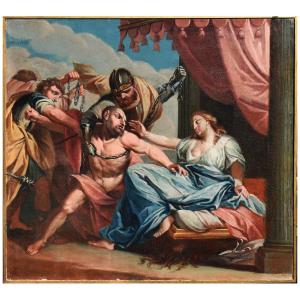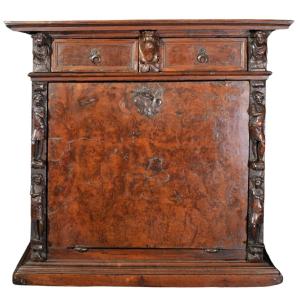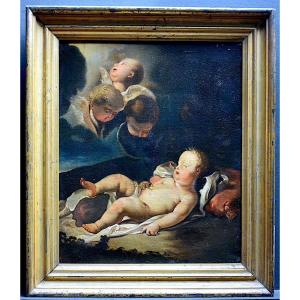Samson and Delilah
Oil on canvas, 83 x 91 cm
With frame, 87 x 94 cm
In this intense painting depicting Samson and Delilah, made by a master of the Venetian school of the mid-18th century, the theatrical and dramatic spirit of Baroque art is fully captured. The scene opens on a crucial moment: Samson, betrayed by Delilah, is now deprived of his strength and struggles while being captured by the Philistines. The tension of the bodies, the strongly characterized expressions and the skillful rendering of the draperies are typical elements of Venetian painting of the time, influenced by the great lesson of Tiepolo, Piazzetta and Ricci.
The composition highlights a notable mastery of drawing and a vibrant lighting direction, which accentuates the pathos of the moment and guides the viewer's gaze towards the psychological drama of the protagonists. The lively chromaticism, played on the tones of red, blue and yellow, is equally emblematic of contemporary Venetian painting, always attentive to the material rendering and the preciousness of the surface.
The iconography of Samson and Delilah was very popular in Baroque and Rococo painting. The theme was particularly dear to artists for the possibility of representing the contrast between virile strength and feminine seduction. Samson's sorrowful face and Delilah's composed sensuality reveal a moral as well as aesthetic intention, perfectly in line with the religious and moralizing painting of the Serenissima in the central decades of the eighteenth century.
The scene depicts the moment in which Delilah, after learning from Samson the secret of his strength (his hair never cut), delivers him to the Philistines. Delilah's gesture, who reaches out with apparent care towards the hero, is ambiguous, suspended between pity and betrayal. Samson, half naked and chained, is still depicted in a heroic posture but already defeated, a symbol of the fragility of man in the face of seduction. The iconography originates from the biblical text (Book of Judges, 16) and has often been used as an allegory of the conflict between reason and passion, strength and weakness, virtue and sin.
Professional packaging and insured shipping to ensure maximum safety in transport.
For further information do not hesitate to contact us +39 3335747733 – info@dequart.com
Possibility of VIDEO CALLS and direct viewings by appointment in MILAN and OMEGNA (Vb).























 Le Magazine de PROANTIC
Le Magazine de PROANTIC TRÉSORS Magazine
TRÉSORS Magazine Rivista Artiquariato
Rivista Artiquariato